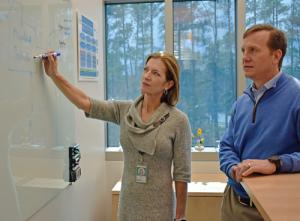We’re Innovating Relentlessly
Keith Dennis is Associate Director, Strategic Initiatives, NRECA.
S. Lee Ragsdale, Jr. is Senior Vice President, Grid Infrastructure and Compliance, North Carolina Electric Membership Corporation.
Diane Huis is Vice President, Resource Planning and Portfolio Management, North Carolina Electric Membership Corporation.
Keith Dennis: We are seeing a lot of electrification in a variety of sectors, most notably in electric vehicles, but also in irrigation systems and some industrial processes. What is changing, and what technologies are really transforming electricity as a resource?

Lee Ragsdale: Technology is rapidly evolving to reduce cost and ease of implementation of items that enable electrification across sectors.
Also, there's a greater awareness and desire to make changes to how we, as consumers, use energy. The confluence of those two trends is driving a move toward greater electrification.
Battery storage is enabling renewables, and it's also changing the idea of resilience on the grid. Batteries can lead to non-wires alternatives, instead of bigger wires, bigger transformers, and other infrastructure.
The change in technology is beginning to expose more opportunities for us to think differently about our business.
 Lee Ragsdale: Any technology that can reduce costs for our members and our larger customers, and help the environment at the same time, is something that our members and consumers are very interested in.
Lee Ragsdale: Any technology that can reduce costs for our members and our larger customers, and help the environment at the same time, is something that our members and consumers are very interested in.
Diane Huis: North Carolina's electric cooperatives see the potential for technologies to really transform electricity as a resource.
Agribusiness is a large driver of North Carolina's economy. It's especially prevalent in the rural parts of the state that our cooperative serves.
Any technology that can reduce costs for our members and our larger customers, and help the environment at the same time, is something that our members and consumers are very interested in.
One example of that is ultraviolet technology that can cleanse water. North Carolina is the number one sweet potato producer in the country. Currently, chlorine is used to cleanse the water that cleans the sweet potatoes before they're processed.
 Diane Huis: We are owned by our members, so we really focus on the value and benefits that technologies can provide, while at the same time, keeping our cost as low as possible for all our consumers.
Diane Huis: We are owned by our members, so we really focus on the value and benefits that technologies can provide, while at the same time, keeping our cost as low as possible for all our consumers.
If we can change that technology and use ultraviolet light to clean the water, that will greatly improve the safety associated with the industrial process. It will also help conserve water, and at the same time, benefit the electric cooperative.
In general, we see any technologies that can transform agribusiness as something that can really make a difference here.
We're still learning about this technology. We are co-sponsoring the EPRI electrification conference in August. While we're there, we're really looking forward to learning more about these different processes.
We also are hoping to brainstorm more with others in our industry and other industries and share what we learned through the technologies that we are putting into place.
Keith Dennis: Co-ops in North Carolina have a unique relationship with their consumers, who are also the co-op owners. How does the co-op business model influence your decisions on deploying new technologies?
Diane Huis: North Carolina's electric co-ops are driven by innovation and commitment to service.
We are owned by our members, so we really focus on the value and benefits that technologies can provide, while at the same time, keeping our cost as low as possible for all our consumers.
We look at how technology directly impacts our consumers. For example, does it give them more control over their electricity costs? Then we look at what the technology can provide, from the standpoint of lowering the cost of our wholesale power supply.
Other factors, such as the reliability and resiliency of our grid, are also considered.
Lee Ragsdale: Co-ops are at the forefront of these innovative technologies because of our business model, and focus on our members.
We are owned and directed by those we serve, and we are in touch with our members' needs and expectations. Our member cooperatives are nimble and able to deploy technology like AMI and thermostats as they see fit, and in manageable chunks.
The independent, autonomous structure of the co-ops gives us the flexibility to pilot a number of different programs and different structures, to see what works best for different regions of our state.
We also benefit from a strong cooperative network. All co-ops are guided by seven cooperative principles. One of those is cooperation among cooperatives.
In North Carolina, electric co-ops are working together with NCEMC, a generation and transmission cooperative serving most of the North Carolina co-ops, on several pilot programs.
Sharing lessons learned from the pilots allows our individual member cooperatives to benefit from the work that they each have done.
Keith Dennis: How is technology changing the consumer's interaction with the grid?
Lee Ragsdale: That is the amazing thing. The technology is changing how consumers interact and think about the grid. Years ago, demand response was a utility-owned switch that turned off your air conditioner, for instance. At that time, it completely turned off, so it was just blowing warm air, which could be an inconvenience to consumers.
Now, demand response is a Wi-Fi-connected thermostat that allows the utility to adjust the temperature set point for a few degrees in a home. Or it is a smart water heater control that heats water only when the value is best, yet still delivers hot water when needed.
The consumer sees these adjustments, understands why the change is made and sees the benefit on their bill each month. Consumers can now see how they are saving themselves and saving their neighbors on their energy bills, and that is a different way to interact with the grid.
Diane Huis: Technologies are allowing cooperatives to put tools and programs in place to further engage with their members.
For example, in North Carolina, co-ops have been in the forefront of deploying pre-paid metering for their members. That was driven by technology on the meter reading side, as well as evolutions in payment technologies.
We have found that tools such as prepaid billing that allow consumers to manage their own energy consumption also help consumers interact more with the utility. Participating members appreciate the options for better energy management, and they are generally more satisfied with their service provider.
It also helps members see their co-op as an energy partner, rather than just an electricity provider.
Overall, we're seeing increased member engagement, and that is a focus for us.
Keith Dennis: What are some of the technologies that can benefit both consumers and electric systems?
Diane Huis: Conservation voltage reduction is a valuable technology that benefits the electric system through increased efficiencies. Consumers benefit from reduced energy costs, and cooperatives benefit from value found by using their distribution systems even more efficiently.
Another example can be found in electric vehicles. EVs could benefit utilities through off-peak charging and by potentially supplying ancillary services in the future. There are also consumer benefits, including a lower cost per mile and lower maintenance cost. And of course, there are benefits to the environment from reduced emissions.
Lee Ragsdale: Thermostats, batteries, microgrids, energy management systems: all of these technologies benefit both consumers and electric utilities.
The concept of a microgrid is important to consider. Microgrids in various forms have existed for many years. Many buildings, such as hospitals and offices, have backup generation that allows them to island in an emergency. Those systems are typically inward facing.
But battery storage, communication and control technology, and energy management systems are allowing the microgrid controller to turn and face the utility to benefit the greater electric system. That improves reliability for the site and also improves reliability for the community. This can improve cost as well.
We have two microgrid projects in North Carolina that we've been working on for the past year, that are giving electric cooperatives opportunities to improve resilience in their communities.
These projects also are allowing us to test technologies and learn how to better optimize the grid, and at the same time, improve the deployment of renewable technologies.
We're really excited about how we can work closely with electric cooperatives across the state to improve resiliency and implement technologies that will provide better service for cooperative members.
Keith Dennis: Do you see any other benefits of the electric technology that you're deploying?
Diane Huis: That is the great thing about electrification: fuels that are used to produce electricity continue to get cleaner and cleaner. Changes are being made to the system. The benefit is felt by all consumers. We feel electrification is win-win-win, providing benefits to consumers, to utilities and to the environment.
Keith Dennis: Do you see any parallels between the current transformation and the electrification movement of the 1930s?
Lee Ragsdale: Yes. Eighty years ago, neighbors in rural areas worked together to form cooperatives and build the infrastructure that brought electricity to their farms. With that electricity came new opportunity for convenience, efficiency and economic success.
The electric cooperatives stayed in tune with members' expectations and consistently innovated to meet and exceed their needs.
Now, while technology changes the role of the grid and what's possible for electric utilities, our mission of service stays the same. We're happy now to have more tools to achieve that mission.
Electrification will provide new opportunities and benefits, and cooperatives are good at bringing those benefits to the members in our communities.
PUF 2.0 Articles: We’re Innovating Relentlessly
Prioritizing Efficient Electrification R&D, Convening Stakeholders — By Steve Mitnick, with EPRI SVP Arshad Mansoor
Utilities’ Passion and Hard Work on EV Future — By Steve Mitnick, with EEI’s Lisa Wood and Becky Knox
Rural Power Designing the Future Too — By Steve Mitnick, with NRECA’s Keith Dennis
Future is Now in North Carolina — By NRECA’s Keith Dennis with NCEMC’s Lee Ragsdale and Diane Huis



